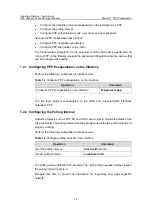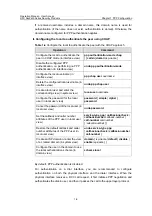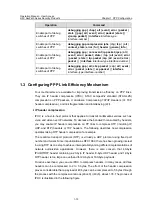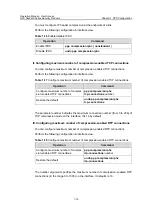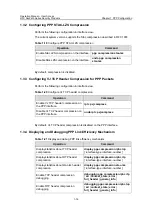
Operation Manual – User Access
H3C SecPath Series Security Products
Chapter 1 PPP Configuration
1-5
If a received username includes a domain name, this domain name is used for
authentication (if the name does not exist, authentication is denied). Otherwise, the
domain name configured for PPP authentication applies.
II. Configuring the local to authenticate the peer using CHAP
Table 1-4
Configure the local to authenticate the peer with the CHAP approach
Operation
Command
Configure the local to authenticate the
peer in CHAP mode (in interface view)
ppp
authentication-mode
chap
[ [
call-in
]
domain isp-name
]
Disable the configured PPP
authentication, i.e. performing no PPP
authentication (in interface view)
undo ppp authentication-mode
Configure the local username (in
interface view)
ppp
chap
user
username
Delete the configured local username (in
interface view)
undo ppp chap user
Create a local user and enter the
corresponding view (in system view)
local-user
username
Configure the password for the local
user (in local user view)
password
{
simple
|
cipher
}
password
Cancel the password of the local user (in
local user view)
undo password
Set the callback and caller number
attributes of the PPP user (in local user
view)
service-type ppp
[
callback-nocheck
|
callback-number callback-number
|
call-number call-number
[
:subcall-number
] ]
Restore the default callback and caller
number attributes of the PPP user (in
local user view)
undo service-type ppp
[
callback-nocheck
|
callback-number
|
call-number
]
Create an ISP domain or enter the view
of a created domain (in system view)
domain
{
isp-name
|
default
{
disable
|
enable isp-name
} }
Configure the user in the domain to use
the local authentication scheme (in
domain view)
scheme local
By default, PPP authentication is disabled.
For authentication on a dial interface, you are recommended to configure
authentication on both the physical interface and the dialer interface. When the
physical interface receives a DCC call request, it first initiates PPP negotiation and
authenticates the dial-in user, and then it passes the call to the upper layer protocol.





